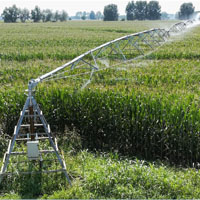Evaluation of ammonia emissions from filtration of digestate used for fertigation

Accepted: 12 July 2021
HTML: 25
All claims expressed in this article are solely those of the authors and do not necessarily represent those of their affiliated organizations, or those of the publisher, the editors and the reviewers. Any product that may be evaluated in this article or claim that may be made by its manufacturer is not guaranteed or endorsed by the publisher.
Authors
Fertigation can be a suitable technique for utilizing digestate, minimizing nitrogen losses, and contributing to circularity within a farming system. For this purpose, digestate usually is first processed with a screw-press separator. However, further filtration is required to remove particles that could clog the nozzles of drip or sprinkling irrigation systems. Advanced filtration can be obtained using mechanical separation with screens having openings of 100- 300 μm. This operation can be another source of ammonia emission, but this aspect has not been adequately investigated. This study aimed to address this knowledge gap by evaluating the emissions from three different filtration systems for digestate. The study was conducted in three different farms located in Lombardy (Italy) using digestate to fertigate maize by drip irrigation (two farms) and pivot irrigation (one farm). Ammonia emissions were measured with passive samplers and the fluxes were examined using an inverse dispersion model implemented in Windtrax software. The emissions were measured both when the filtration systems were in operation and when they were switched off. Ammonia emissions (mean values between 375 and 876 μg NH3/m2/s) tended to increase during operation of the filtration systems. However, no significant differences were found in the emissions from active and inactive equipment on any of the farms. The emissions from the filtration systems were higher than from a storage tank (22-67 μg NH3/m2/s). However, the mean emissions amounted to only 0.3% of the nitrogen content of the digestate. These emissions can be considered irrelevant in the context of the whole management scheme for digestate. This work provides a first insight on ammonia emissions arising from advanced filtration of digestate, with specific reference to Po Valley farming systems. Further studies are required to improve knowledge about emissions from the entire digestate management process, including the treatments required for specific application techniques.
How to Cite

This work is licensed under a Creative Commons Attribution-NonCommercial 4.0 International License.
PAGEPress has chosen to apply the Creative Commons Attribution NonCommercial 4.0 International License (CC BY-NC 4.0) to all manuscripts to be published.

 https://doi.org/10.4081/jae.2021.1187
https://doi.org/10.4081/jae.2021.1187



